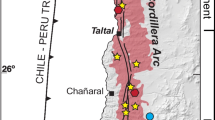Abstract
This report is a petrographic study of alteration phenomena in an area of 100 km2 in the Coastal Range west of Santiago. The stratified sequence of the area is of Cretaceous age and belongs to the western monoclinal limb of the Andean Geosyncline. Two structural units are present, separated by an angular unconformity. The older is about 9,000 m thick, and the younger 300 m thick. The rock types are mostly altered andesitic flows and flow breccias, and keratophyric ignimbrites and lavas, with alternating marine, brackish-water and terrestrial interbeds. Stratified rocks are cut locally by acid and basic apophyses and dikes, probably feeders of their volcanic host rocks. Discordant Cretaceous granitic plutons intrude the older unit.
Throughout the whole stratigraphic section there are alteration minerals, which selectively replace the primary minerals, or fill amygdules and open fractures, or form a cement in flows, dikes and sedimentary interbeds. Patterns of alteration are regular and persistent; they correlate on a large scale with stratigraphic level and on a smaller scale with position within each individual flow and situation within amygdules.
The stratigraphically controlled pattern is as follows:
The pattern of alteration in the older unit is comparable to that described for burial metamorphosed sequences in New Zealand and Australia. Reappearence of the greenschist facies at a higher level in the younger unit poses a problem for which several explanations are possible.
The smaller scale pattern of alteration shows a persistent tendency —not without exception — for the “grade” of the alteration assemblage (as correlated with depth on the large scale) to increase: from the base of the flow (non-amygdaloidal part) upward (amygdaloidal part), and from the rim of each amygdule inward.
Also recognizable on the scale of a single flow is a tendency for upward increase in: a) extent of alteration (the basal zone may be fresh andesite), and b) weight percent of Na2O, K2O (with complementary depletion in CaO), and of Fe2O3/FeO.
Preliminary observations indicate that this alteration pattern persists for at least 400 km north of the area here described in rocks of similar lithology and age. It is unrelated to local granitic plutons.
Similar content being viewed by others
References
Battey, M. N.: Alkali metasomatism and the petrology of some keratophyres. Geol. Mag. 92, No 2, 104–126 (1955).
Brown, E. H.: The Greenschist facies in part of Eastern Otago, New Zealand. Contr. Mineral. and Petrol. 14, 259–292 (1967).
Coombs, D. S.: The pumpellyite mineral series. Mineral. Mag. 30, 113–135 (1953).
- Lower grade mineral facies in New Zealand. Copenhagen, 21th Internat. Congr., Norden, part 13, p. 339–351 (1960).
—: Some recent work on the lower grades of metamorphism. Australian J. Sci. 24, 203–215 (1961).
—, A. J. Ellis, W. S. Fyfe, and A. M. Taylor: The zeolite facies with comments on the interpretation of hydrothermal syntheses. Geochim. Cosmochim. Acta 13, 53–107 (1959).
Deer, W. A., R. A. Howie, and J. Zussmann. Rock forming minerals. New York, N.Y.: John Wiley (1962).
Kuno, H., and H. H. Hess: Unit cell dimensions of clinoenstatite and pigeonite in relation to the common pyroxenes. Am. J. Sci. 251, 741–752 (1953).
Levi, B.: Cretaceous volcanic rocks from a part of the coast range West from Santiago, Chile: A study in lithology variation and burial metamorphism in the Andean Geosyncline: Ph D Diss., Univ. of California, Berkeley, Dept. of Geology (1968).
- Low grade burial metamorphic patterns of the Andean Geosynclinal Deposits in Central Chile. (In prep., 1969).
-, and J. Corvalán: Metamorfismo regional en las rocas volcánicas del Geosinclinal Andino. Santiago, Chile, Rev. Minerales, No 86, p. 6–15 (1964).
- - Espesor y distribución de los depósitos del Geosinclinal Andino en Chile Central Santiago, Chile, Rev. Minerales, No. 101 p. 13–15 (1968).
Packham, G. H., and R. A. W. Crook: The principle of diagenetic facies and some of its implications. J. Geol. 68, 392–407 (1960).
Ruegg, N. R.: Use of the angle A1Λc in optical determination of the composition of augite. Am. Mineralogist 49, 599–606 (1964).
Seki, Y.: Relation between chemical composition and lattice constants of epidote. Am. Mineralogist 44, 720–730 (1959).
Slemmons, D. B.: Determination of volcanic and plutonic plagioclases using a three-or-fouraxis universal stage: Revision of Turner method. Geol. Soc. Am. Spec. Papers 69, 64 p. (1962).
—: A method of evaluating order-disorder, in: Observation on order-disorder relations of natural plagioclase. Copenhagen, Norsk Geol. Tidsskr. 42, pt. 2 (Feldspar Volume), p. 533–554 (1962a).
Thomas, H.: Informe geológico sobre la Cordillera de la Costa entre la Cuesta de Barriga y Calera. Santiago, Chile, Inst. Invest. Geol., unpublished report (1954).
- Geología de la Cordillera de la Costa entre el valle de La Ligua y la Cuesta de Barriga. Santiago, Chile, Inst. Invest. Geol., Bol. 2, 96 p. (1958).
Turner, F.: Metamorphic petrology. New York: McGraw Hill (1968). 403 p.
Author information
Authors and Affiliations
Rights and permissions
About this article
Cite this article
Levi, B. Burial metamorphism of a Cretaceous volcanic sequence west from Santiago, Chile. Contr. Mineral. and Petrol. 24, 30–49 (1969). https://doi.org/10.1007/BF00398751
Received:
Issue Date:
DOI: https://doi.org/10.1007/BF00398751




